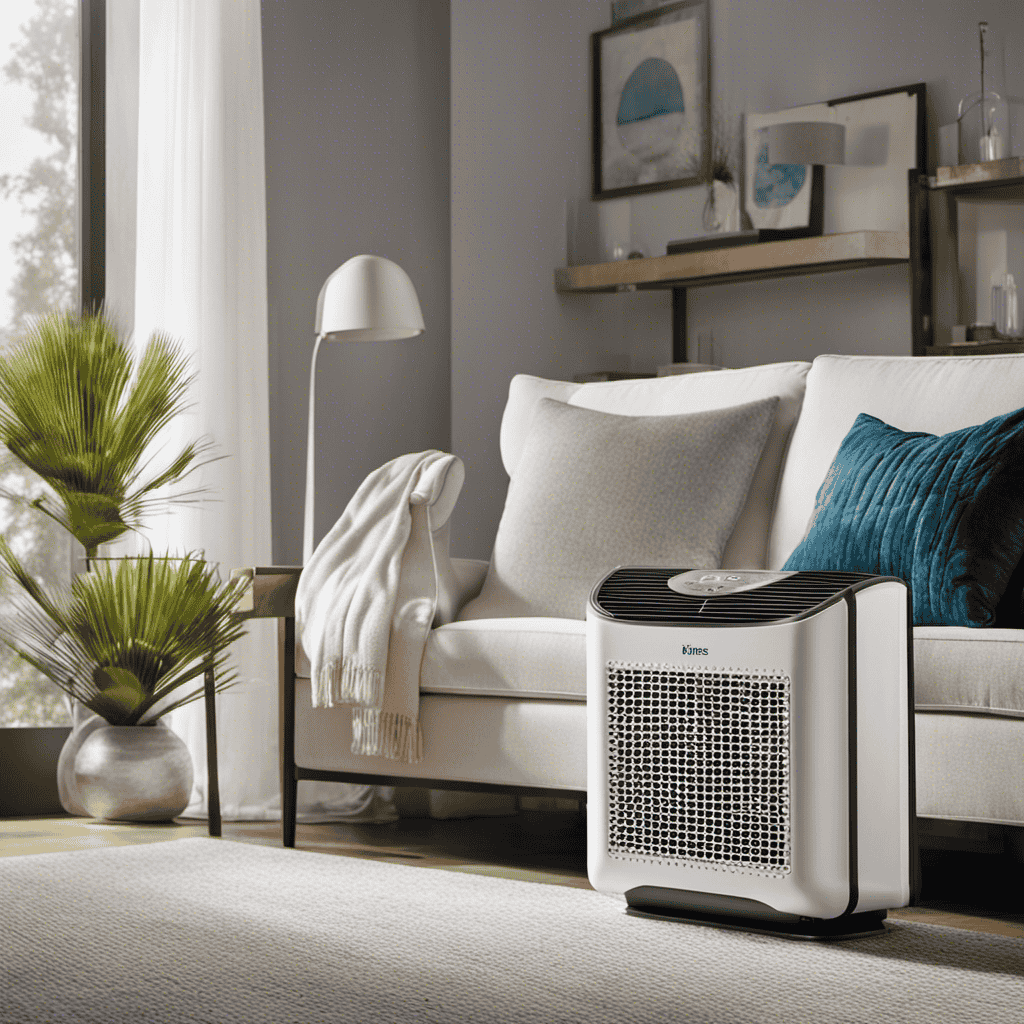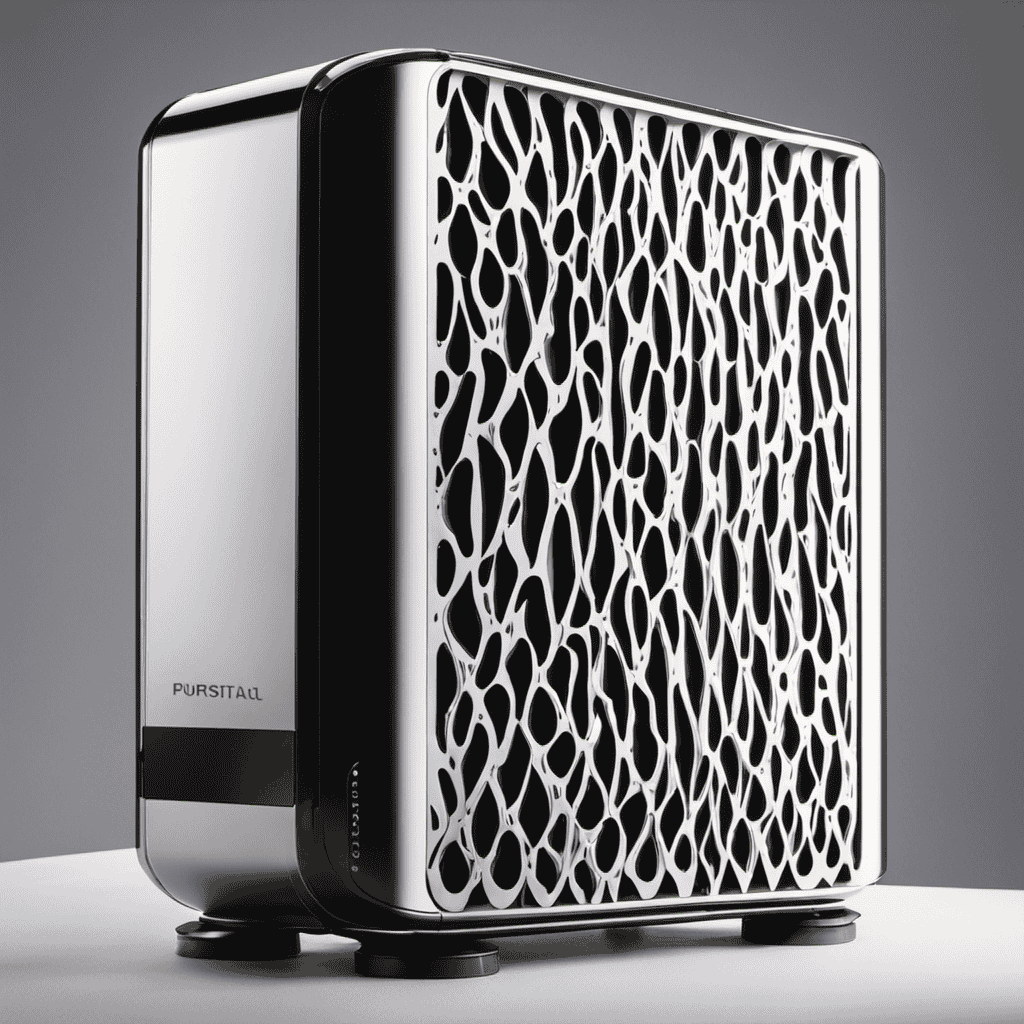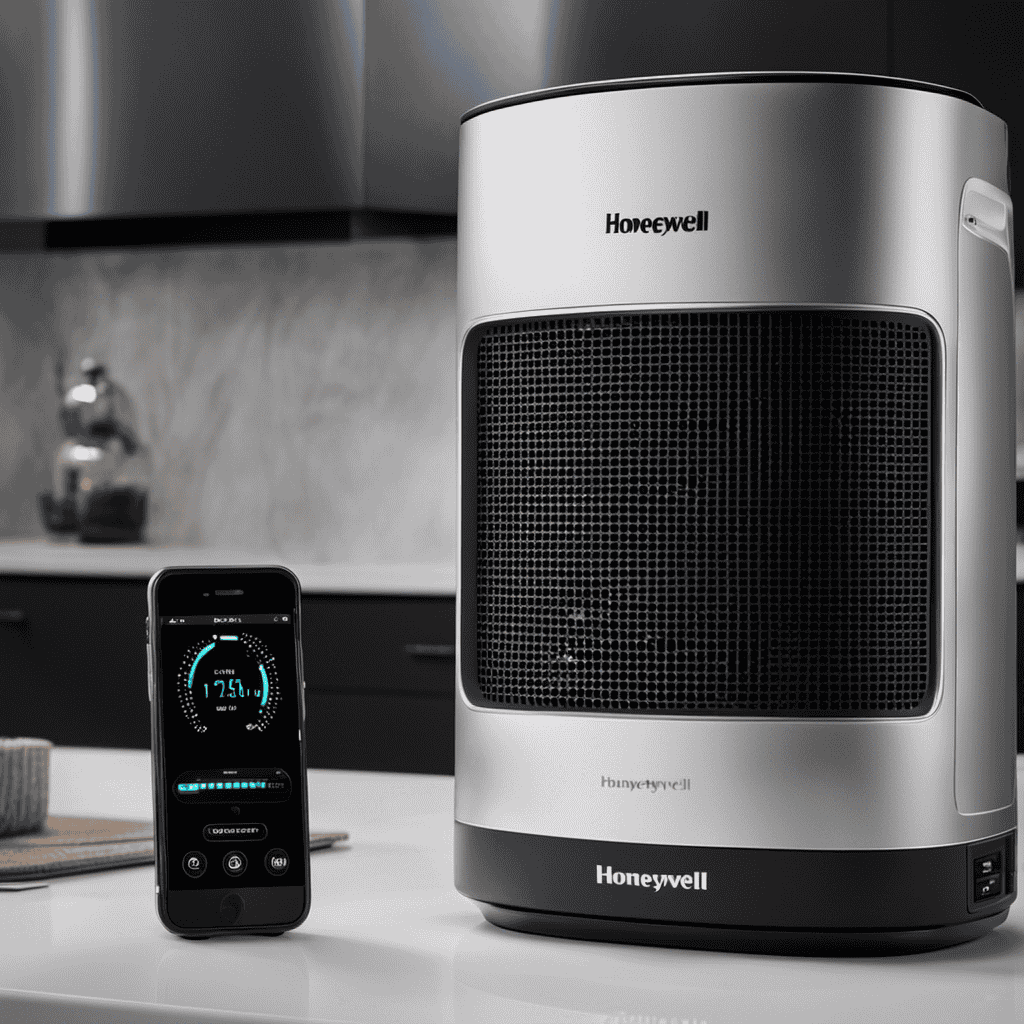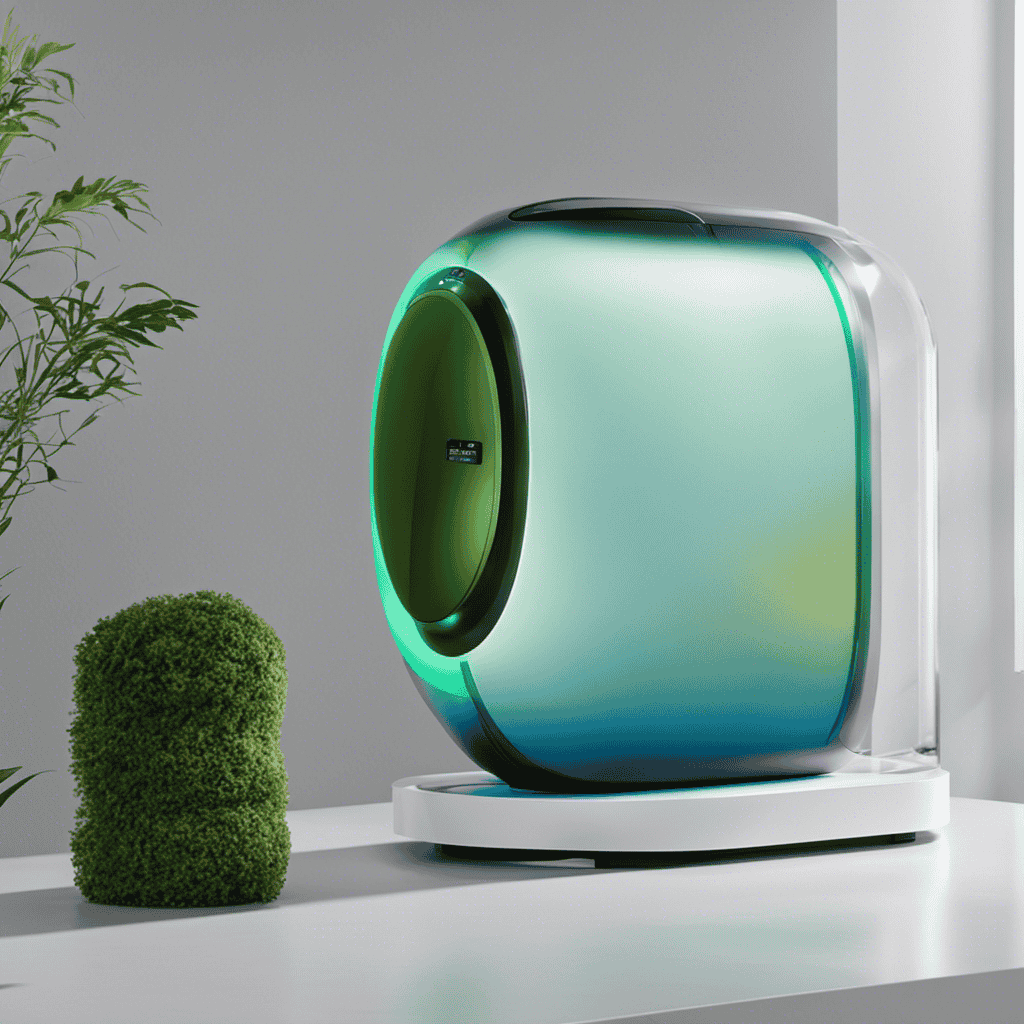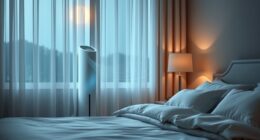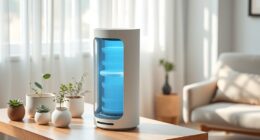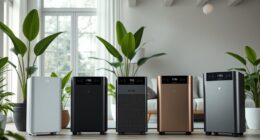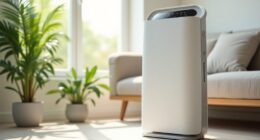Have you ever thought about how many hours a day you should run your home air purifier?
In this article, I will provide you with the necessary information to optimize the performance and efficiency of your IQAir air purifier.
We will explore the importance of using an air purifier at home, understand air quality levels and their impact on health, and discuss factors to consider when choosing the right purifier.
So, let’s dive in and learn how to create a cleaner, healthier living environment.
Key Takeaways
- It is important to use an air purifier at home to remove common air pollutants, reduce the risk of respiratory issues, eliminate unpleasant odors, and create a healthier living environment.
- Understanding air quality levels and their impact on health is crucial as air pollution can lead to respiratory problems, cardiovascular diseases, allergies, and weakened immune systems.
- When choosing a home air purifier, factors to consider include the size of the room, specific pollutants to target, budget, and the purifier’s effectiveness in removing pollutants.
- Recommended daily usage hours for maximum air purification depend on the size of the space, air quality in the area, personal respiratory issues, and the need for clean air balanced with a peaceful environment. Regular maintenance and positioning the purifier correctly can optimize performance and efficiency.
The Importance of Using an Air Purifier at Home
Using an air purifier at home is important for improving indoor air quality. The benefits of using an air purifier are numerous.
First and foremost, it helps to remove common air pollutants found in homes. These pollutants include dust, pollen, pet dander, mold spores, and even volatile organic compounds (VOCs) released from household products. By capturing and trapping these pollutants, an air purifier helps to reduce the risk of respiratory issues, allergies, and asthma attacks.
Additionally, it can eliminate unpleasant odors, leaving your home smelling fresh and clean. Furthermore, an air purifier can help to create a healthier living environment, especially for individuals with compromised immune systems or respiratory conditions.
Overall, using an air purifier is essential for maintaining clean and healthy indoor air quality.
Understanding Air Quality Levels and Their Impact on Health
To fully grasp the impact of air quality levels on your health, it’s important to understand how they can affect you. Air pollution can have detrimental effects on your respiratory system, cardiovascular health, and overall well-being. Here are four key ways in which air pollution can impact your health:
- Respiratory problems: Exposure to polluted air can lead to respiratory conditions such as asthma, bronchitis, and even lung cancer.
- Cardiovascular issues: Poor air quality can increase the risk of heart attacks, strokes, and other cardiovascular diseases.
- Allergies and irritations: Air pollution can trigger allergies, cause eye and throat irritations, and worsen existing respiratory conditions.
- Reduced immunity: Long-term exposure to air pollution can weaken your immune system, making you more susceptible to infections and diseases.
Understanding these air pollution effects highlights the importance of indoor air quality testing and taking steps to improve the air you breathe.
This brings us to the subsequent section, where we will discuss the factors to consider when choosing the right home air purifier.
Factors to Consider When Choosing the Right Home Air Purifier
When selecting the right home air purifier, it’s essential to consider factors such as the size of the room, the specific pollutants you want to target, and your budget. These factors will help determine the type and features of the air purifier that will best meet your needs.
The size of the room is important because it affects the air purifier’s coverage area. You want to make sure the purifier is powerful enough to clean the air in the entire room.
Additionally, different air purifiers are designed to target different pollutants, such as dust, allergens, or pet dander. Considering your specific needs will ensure you choose a purifier that effectively removes the pollutants you are concerned about.
Finally, your budget will determine the range of options available to you. By taking these factors into account, you can select the right air purifier for your home.
Now that we have discussed the factors to consider when choosing a home air purifier, it’s important to also consider the recommended daily usage hours for maximum air purification.
Recommended Daily Usage Hours for Maximum Air Purification
It’s important to note the recommended daily usage hours for maximum air purification to ensure the effectiveness of your chosen home air purifier. Here are some key points to consider:
-
Determine the size of your space: Different air purifiers have different coverage areas, so it’s crucial to select a purifier that matches the size of your room or home.
-
Understand the air quality in your area: If you live in an area with high pollution levels or have respiratory issues, you may need to run your air purifier for longer periods.
-
Consider noise levels: Some air purifiers can be noisy, so it’s important to balance the need for clean air with the comfort of a peaceful environment.
-
Follow the recommended maintenance schedule: Regularly clean and replace filters according to the manufacturer’s instructions to ensure optimal performance.
Using an air purifier in the workplace can have several benefits, including improved air quality, reduced allergies and respiratory issues, and increased productivity.
How Long Does It Take for an Air Purifier to Clean the Air in a Room
Air purifiers typically take a few hours to effectively clean the air in a room. The time it takes depends on several factors, such as the size of the room and the air purifier’s CADR (Clean Air Delivery Rate). A higher CADR means faster air purification. To give you an idea of how long it may take, here is a table showing the estimated time for different room sizes and CADR levels:
| Room Size (square feet) | CADR Level (in cubic feet per minute) | Estimated Time for Air Purification |
|---|---|---|
| Up to 200 | 100 | 1-2 hours |
| 201-400 | 200 | 2-4 hours |
| 401-600 | 300 | 3-6 hours |
| 601-800 | 400 | 4-8 hours |
Air purifiers offer numerous benefits, including reducing allergens, removing pollutants, and improving indoor air quality. However, their effectiveness depends on factors like the room size, CADR, and the presence of other sources of air pollution. Optimizing the performance and efficiency of your home air purifier can further enhance its cleaning capabilities and prolong its lifespan.
Now let’s explore some tips for maximizing the efficiency of your air purifier.
Tips for Optimizing the Performance and Efficiency of Your Home Air Purifier
When it comes to optimizing the performance and efficiency of your home air purifier, there are three key points to consider: filter maintenance frequency, ideal room placement, and noise level management.
First, it’s crucial to regularly clean or replace the filters in your air purifier to ensure that it can effectively remove pollutants from the air.
Second, the placement of your air purifier in the room is important as it should be positioned in a central location to ensure optimal air circulation.
Lastly, managing the noise level of your air purifier is essential for a comfortable living environment, and selecting a model with noise-reducing features can help achieve this.
Filter Maintenance Frequency
You should regularly check and clean the filters in your home air purifier to maintain its efficiency. Proper filter maintenance is crucial to ensure the effectiveness of your air purifier in removing pollutants from the air.
Here are some guidelines for maintaining your air purifier filters:
-
Check the filters every month: Regularly inspect the filters to see if they are dirty or clogged. This will help you determine when they need to be cleaned or replaced.
-
Clean the pre-filter: If your air purifier has a pre-filter, clean it every two weeks. This will remove larger particles and prolong the life of the main filters.
-
Replace the filters as needed: Depending on the air quality and usage, the filters may need to be replaced every 6 to 12 months. Follow the manufacturer’s instructions for proper replacement.
-
Keep a maintenance schedule: Create a schedule to remind yourself to check and clean the filters regularly. This will ensure that your air purifier operates at its optimal efficiency.
By regularly maintaining your air purifier filters, you can ensure they are functioning effectively and efficiently.
Now, let’s move on to discussing the ideal room placement for maximum air purification.
Ideal Room Placement
Finding the ideal room placement for your air purifier is essential for maximizing its effectiveness. Here are some placement tips to consider.
First, place the air purifier in the room where you spend the most time, such as the bedroom or living room. This will ensure that you are breathing in clean air for extended periods.
Additionally, it is recommended to place the air purifier at least three feet away from walls or furniture to allow for proper airflow. Avoid placing it in a corner or under a table, as this can restrict air circulation.
Lastly, consider the impact on sleep quality when deciding on the placement. Placing the air purifier near your bed can help remove allergens and pollutants, leading to a better night’s sleep.
Noise Level Management
When it comes to managing the noise level of an air purifier, there are a few important factors to consider. Here are some tips to help you reduce noise and improve your sleep:
-
Choose a quiet air purifier: Look for models that are specifically designed for noise reduction. These typically have advanced sound insulation and low-noise fans.
-
Optimize placement: Position your air purifier away from walls or furniture that may obstruct airflow. This can help minimize noise caused by air turbulence.
-
Use a sleep mode: Many air purifiers come with a sleep mode feature that operates at a lower fan speed, reducing noise levels during the night while still maintaining effective air purification.
-
Consider white noise: If the ambient noise from the air purifier bothers you, you can try using a white noise machine or a fan to create a soothing background sound that can help mask any unwanted noise.
Conclusion
In conclusion, using a home air purifier is crucial for maintaining clean and healthy indoor air quality. By understanding air quality levels and selecting the right purifier for your needs, you can ensure maximum purification.
It is recommended to use the air purifier for around 8-12 hours per day to effectively remove pollutants. Interestingly, studies have shown that indoor air can be up to 5 times more polluted than outdoor air, highlighting the importance of investing in an air purifier for your home.



